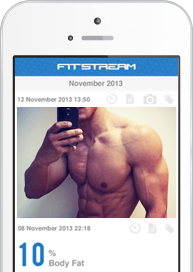How to do Ring Pull-ups
- Adjust the height of the gym rings so that your feet will not touch the ground between repetitions.
- Stand under the rings and grip with either an overhand (for the pull-up), or underhand (for the chin-up) hand position. The free movement of the rings means that your grip does not have to be strictly one position or the other, and it may change throughout the exercise.
- Keep your arms straight and simply dead hang from the rings, keeping your body vertical.
- Pull your chest up toward the gymnastic rings by bending your arms. Keep the movement smooth, slow and controlled and try not to jerk any muscles as you pull-up.
- Pause for a moment at the top of the exercise before you start slowly lowering yourself back down.
- Once you are lowered back to the hanging position, pause, and repeat the exercise.
Notes:
- Throughout the exercise keep your torso straight, legs together, and shoulders relaxed.
- Minimize any rocking or swaying movements.
- Practice the false grip pull-up to strengthen your wrists and prepare for the muscle-up.
Ring Pull-ups Guide
The standard, fixed bar pull-up is an incredibly effective bodyweight exercise and the ring pull-up even more so. It's one of the best exercises to build upper-body strength and muscular definition and is a fundamental human movement.
Many people buy fitness rings primarily for pull-ups, which have many benefits over using a standard static pull-up bar. Whilst a bar or pull-up station will lock your hands in place and limit shoulder mobility, using gymnastic rings for pull-ups will exploit the free movement of the rings and makes the motion more natural and kinder on the joints.
Many people find that they can achieve more repetitions using rings for pull-ups rather than a fixed bar and people who have previously injured their shoulders and find it difficult to do standard pull-ups often find that they can use rings to do the exercise.
During a ring pull-up, you will usually find that the rings rotate and your hand position can change from more of an overhand, pull-up style grip into an underhand chin-up position. Whatever feels most natural and enables you to safely complete full-range repetitions is recommended, but hand position will call different muscles into play. When palms are facing you (the chin-up) it targets the biceps and lats more, whilst palms away from you (the pull-up) will focus more upon upper back muscles.
It's also worth noting that the distance of the rings from one another will determine the exercise difficulty and which muscles are targeted. The greater the distance between the rings, the wider the grip, which focuses effort on the lat muscles, whilst a narrower grip works the middle back.
Beginning Ring Pull-ups
The ring pull-up is not an easy exercise and many people can't do one full repetition but don't worry, there is an easy path to slowly build your strength up for the movement, and we've outlined common techniques to get you started:
Assisted pull-ups
One technique is assisted pull-ups - in which additional equipment is used to support a portion of your body weight and help make the exercise more achievable, yet still challenging. As you gain strength you can gradually work your way up to performing the exercise unaided, using full body weight.
This can be as simple as using a box, chair, or bench for leg-assisted pull-ups by placing the object underneath the rings and supporting one foot (or two for additional help) on the platform. As you lift yourself, straighten the supported leg for assistance, using as little assistance as possible.
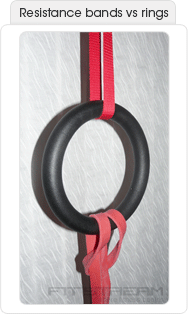
Resistance band assisted pull-ups
Similar to the assisted pull-up technique above, using heavy-duty resistance bands is another method of lowering the difficulty of the exercise by supporting some of your body weight. These bands are commonly available to buy now and come in various thicknesses to give you varying levels of support as your strength levels increase. They're also great for stretching and mobility work once you're done with them.
To use resistance bands with your rings simply thread the bands through the rings and back through themselves (as pictured) so the loops hang at knee level. Grip the rings and as you hang from them simply put your feet into the hanging elastic loop and the bands will now work to support some of your weight as you do the pull-up. The thicker the bands used the easier the pull-up will be.
Negative pull-ups
Another effective option to build up pull-up strength is to specifically train the negative (the part where you're lowering the body down) portion of the exercise. To do this, stand on a bench (or jump into the exercise, using your momentum to bypass the pull-up part) to get to the top of the movement and simply lower yourself down as slowly as possible to help build the muscles required for the full pull-up.
Body Row
You can also try practicing the Ring Body Row as a stepping stone exercise to develop strength for a full pull-up. The Ring Row is an exercise that uses similar muscles to the pull-up but is much easier to do as your bodyweight is partially supported with feet on the floor.
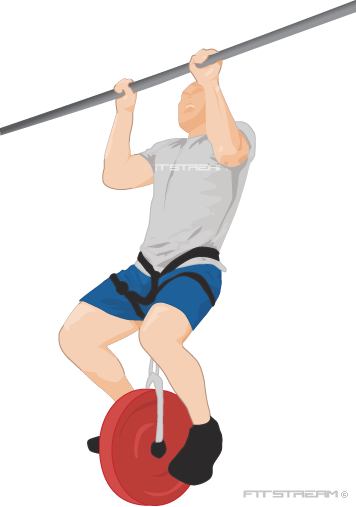 Advanced Ring Pull-ups
Advanced Ring Pull-ups
When you're performing 15+ pull-ups (congratulations - this is no mean feat!) it's time to start considering advanced techniques to overcome plateaus:
Weighted ring pull-ups
Adding more weight to bodyweight exercises can help you develop phenomenal strength but should only be attempted when proficient with the non-weighted versions. You should always start out adding small amounts of weight and increase slowly as you get stronger.
To add weight to your ring pull-ups you can use the following techniques:
- Wear a weighted vest
- Use a dipping belt and attach weights
- Hold a dumbbell or medicine ball between your legs
Advancing to the Muscle-up
A natural progression from the ring pull-up is the muscle-up or ring muscle-up.
The muscle-up is an awesome upper-body exercise that begins as a pull-up exercise and ends with your body being above the rings, as you pull-up and through the top of the movement.
See the full muscle up guide in the Fitstream exercise directory for a detailed guide.
Ring pull-up variations
- Wide ring pull-ups / Narrow ring pull-ups: Adjusting the distance your hands are placed from one another changes the muscles targeted during the exercise.
- Muscle-up: Half pull-up, half dip, double the intensity. A great exercise to progress onto when you've mastered the standard pull-up.
- One-arm ring pull-ups: For the seriously strong, single-arm pull-up training! This is a feat that few ever achieve.
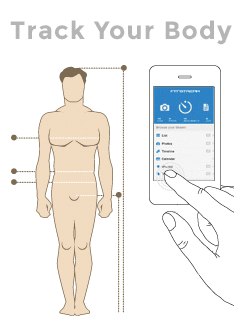 Fitstream AppTrack your fitness progress and see the difference for yourself with our free app
Fitstream AppTrack your fitness progress and see the difference for yourself with our free app
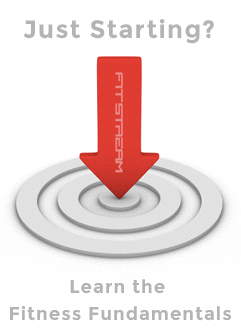

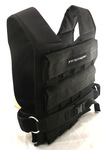


 Advanced Ring Pull-ups
Advanced Ring Pull-ups